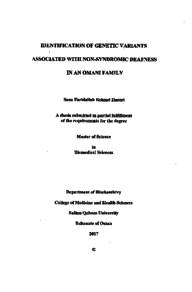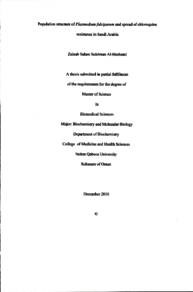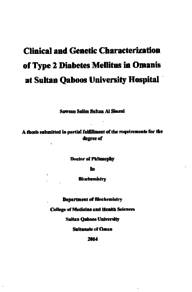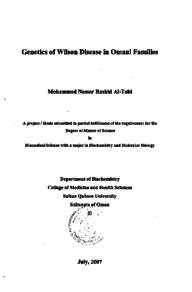Document
Autozygosity mapping of two molecularly uncharacterized autosomal recessive genetic conditions; achalalasia and ataxia-epilepsy in two consanguineous Omani families
Publisher
Sultan Qaboos University
Gregorian
2015
Language
English
Subject
English abstract
Consanguinity increases the likelihood of presence of pathogenic mutations in a homo-allelic state. Oman is characterized by high rate of consanguinity which has an adverse outcome by increasing the risk of autosomal recessive conditions. These are the commonest type of diseases in Oman and significantly contribute in increased rate of morbidity and mortality. Identification of the disease-related genes leads immediately to expand knowledge of the functional role of the altered gene and offers better understanding of the physiological basis of the disease phenotype. Autozygosity mapping is a powerful approach that is widely used for detection of autosomal recessive disorders in consanguineous families. This study aimed to uncover the genetic basis of two inherited autosomal recessive conditions in Omani families. Two consanguineous Omani families with different autosomal recessive disorders were enrolled in the study. The first family was characterized by achalasia while the second family has ataxia and epilepsy. Single Nucleotide Polymorphism array has been used to identify the shared autozygous regions between affected individuals. The most promising candidate genes were selected using different filtering approaches related to similarities in functions and pathways. The strongest candidate genes were sequenced and the identified variants were evaluated using in silico mutation prediction tools.
For the family with achalasia, the GUCY1A3 gene, that was recently known to cause achalasia, was considered as the strongest candidate gene. One splice site variant, predicted to affect splicing, was identified. Further evaluations are recommended to confirm its causality by studying its cosegregation with the disorder and its effect on mRNA splicing. For the family with ataxia and epilepsy, the GOSR2 gene showed similar phenotypes to our patients but not identical and thus considered as the promising candidate gene. No causative variant was identified in this gene. The potential next step is to sequence promotor and downstream untranslated regions in GOSR2 and to genotype additional patient that would allow refining the candidate regions.
Member of
Resource URL
Arabic abstract
زواج الأقارب يزيد من احتمالية وجود الطفرات المسببة للأمراض في حالة تماثل اليلي لكلا نسختي المورث. تتميز سلطنة عمان بارتفاع معدل زواج الأقارب الذي قد يؤدي إلى نتائج عكسية من خلال زيادة خطر الإصابة بالأمراض الوراثية المتنحية. وهذه هي أكثر الأمراض شيوعا في سلطنة عمان وتساهم بشكل كبير في زيادة معدلات المرض والوفيات. إن التعرف على الجينات المسببة للأمراض يؤدي على الفور إلى توسيع نطاق معرفة الدور الوظيفي لهذا الجين ويقدم فهما أفضل للأسس الفسيولوجية للنمط الظاهري للمرض. تقنية (Autozygosity mapping) هي نهج قوي وناجح يستخدم بشكل واسع للكشف عن الأمراض المتنحية في الأسر التي تتميز بزواج الأقارب. هدفت هذه الدراسة إلى الكشف عن الأساس الجيني لبعض الأمراض الوراثية المتنحية في الأسر العمانية في هذه المشروع تمت دراسة عائلتين عمانيتين تتميزان بزواج الأقارب مصابتين بأمراض وراثية متنحية مختلفة الأسرة الأولى مصابة بمرض تعذر الارتخاء في قصبة المريء (esophageal achalasia)، بينما الأسرة الأخرى مصابة بمرض الترنح (عدم القدرة على تنسيق حركة العضلات والصرع. استخدمت تقنية (SNP array) لتحديد المناطق ذات الأمشاج المشتركة بين الأفراد المرضى في كلا العائلتين على حدة ضمن هذه المناطق تم ترشيح أقوى الجينات التي قد تسبب المرض استنادا على بعض الخصائص المتماثلة في الوظائف والمسارات الجينية. بعد ذلك تم تحديد التسلسل الجيني الجينات المرشحة وتم تقييم المتغيرات الظاهرة باستخدام برمجيات خاصة بتنبؤ تأثير الطفرات الجينية. بالنسبة للأسرة المصابة بمرض تعذر ارتخاء قصبة المريء، اعتبر جين GUCYIA3 (الذي يعرف في الآونة الأخيرة كمسبب لمرض تعذر ارتخاء قصبة المريء) كأقوى جين مرشح. في هذا الجين وجد متغير جيني في الموقع الذي يربط الانترون التاسع بالاكسون العاشر، ومن المتوقع أن هذا التغير الجيني قد يؤثر على الربط بينهما؛ ولذا ينصح بإجراء تقييمات أخرى لتأكيد العلاقة السببية لهذا الجين من خلال تتبع وراثة الأليل المسبب المرض في أفراد العائلة، ودراسة تأثيره على ربط mRNA بالنسبة للأسرة الثانية المصابة بمرض الترنح والصرع فقد وجد بأن جين GOSR2 يسبب أنماط مرضية ظاهرية مماثلة للأنماط الظاهرية لدى المصابين في العائلة ولكنها غير متطابقة تماما؛ ولذلك فقد تم اعتباره أقوى الجينات المرشحة. النتائج لم تظهر أي متغير جيني قد يسبب المرض في هذا الجبن. الخطوة التالية المحتملة هي تحديد التسلسل الجيني لمنطقة PROMOTOR والمناطق غير المترجمة في نهاية التسلسل الجيني ل GOSR2 ، بالإضافة إلى دراسة التركيب الوراثي للمريض المشخص حديثا لتحديد المناطق ذات الأمشاج المشتركة مع المرضى السابقين بما يتيح إعادة ترتيب هذه المناطق المرشحة من جديد.
Category
Theses and Dissertations







